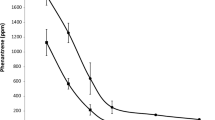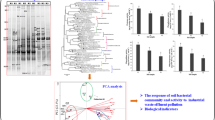Abstract
Pyrene, a representative polycyclic aromatic hydrocarbon (PAH) compound produced mainly from incomplete combustion of fossil fuels, is hazardous to ecosystem health. However, long-term exposure studies did not detect any significant effects of pyrene on soil microorganism. In this study, short-term microcosm experiments were conducted to identify the immediate effect of pyrene on soil bacterial communities. A freshlycollected pristine red soil was spiked with pyrene at 0, 10, 100, 200, and 500 mg·kg−1 and incubated for one day and seven days. The bacterial communities in the incubated soils were analyzed using 16S rRNA sequencing and terminal restriction fragment length polymorphism (TRFLP) methods. The results revealed high bacterial diversity in both unspiked and pyrene-spiked soils. Only at the highest pyrene-spiking rate of 500 mg·kg−1, two minor bacteria groups of the identified 14 most abundant bacteria groups were completely suppressed. Short-term exposure to pyrene resulted in dominance of Proteobacteria in soil, followed by Acidobacteria, Firmutes, and Bacteroidetes. Our findings showed that bacterial community structure did respond to the presence of pyrene but recovered rapidly from the perturbation. The intensity of impact and the rate of recovery showed some pyrene dosage-dependent trends. Our results revealed that different levels of pyrene may affect the bacterial community structure by suppressing or selecting certain groups of bacteria. It was also found that the bacterial community was most susceptible to pyrene within one day of the chemical addition.
Similar content being viewed by others
References
Head IM, Jones DM, Röling WFM. Marine microorganisms make a meal of oil. Nature Reviews Microbiology, 2006, 4(3):173–182
Su Y H, Zhu Y G. Uptake of selected PAHs from contaminated soils by rice seedlings (Oryza sativa) and influence of rhizosphere on PAH distribution. Environmental Pollution, 2008, 155(2):359–365
Tao Y Q, Zhang S Z, Zhu Y G, Christie P. Uptake and acropetal translocation of polycyclic aromatic hydrocarbons by wheat (Triticum aestivum L.) grown in field-contaminated soil. Environmental Science & Technology, 2009, 43(10):3556–3560
Cerniglia C E. Biodegradation of polycyclic aromatic hydrocarbons. Biodegradation, 1992, 3(2–3):351–368
Viñas M, Sabaté J, Espuny M J, Solanas A M. Bacterial community dynamics and polycyclic aromatic hydrocarbon degradation during bioremediation of heavily creosote-contaminated soil. Applied and Environmental Microbiology, 2005, 71(11):7008–7018
Ben Said O, Goñi-Urriza M, El Bour M, Aissa P, Duran R. Bacterial community structure of sediments of the bizerte lagoon (Tunisia), a southern Mediterranean coastal anthropized lagoon. Microbial Ecology, 2010, 59(3):445–456
Deng H, Li X F, Cheng W D, Zhu Y G. Resistance and resilience of Cu-polluted soil after Cu perturbation, tested by a wide range of soil microbial parameters. FEMS Microbiology Ecology, 2009, 70(2):137–148
Paissé S, Coulon F, Goñi-Urriza M, Peperzak L, McGenity T J, Duran R. Structure of bacterial communities along a hydrocarbon contamination gradient in a coastal sediment. FEMS Microbiology Ecology, 2008, 66(2):295–305
Yang H, Su Y H, Zhu Y G, Chen M M, Chen B D, Liu Y X. Influences of polycyclic aromatic hydrocarbons (PAHs) on soil microbial community composition with or without Vegetation. Journal of Environmental Science and Health Part A-Toxic/ Hazardous Substances & Environmental Engineering, 2007, 42(1):65–72
Gao Y Z, Ling W T, Wong M H. Plant-accelerated dissipation of phenanthrene and pyrene from water in the presence of a nonionicsurfactant. Chemosphere, 2006, 63(9):1560–1567
Lin Y T, Huang Y J, Tang S L, Whitman W B, Coleman D C, Chiu C Y. Bacterial community diversity in undisturbed perhumid montane forest soils in Taiwan. Microbial Ecology, 2010, 59(2):369–378
Zhang W, Wang H, Zhang R, Yu X Z, Qian P Y, Wong M H. Bacterial communities in PAH contaminated soils at an electronicwaste processing center in China. Ecotoxicology (London, England), 2010, 19(1):96–104
Sverdrup L E, Ekelund F, Krogh P H, Nielsen T, Johnsen K. Soil microbial toxicity of eight polycyclic aromatic compounds: effects on nitrification, the genetic diversity of bacteria, and the total number of protozoans. Environmental Toxicology and Chemistry, 2002, 21(8):1644–1650
Peng J J, Cai C, Qiao M, Li H, Zhu Y G. Dynamic changes in functional gene copy numbers and microbial communities during degradation of pyrene in soils. Environmental Pollution, 2010, 158(9):2872–2879
Ager D, Evans S, Li H, Lilley A K, van der Gast C J. Anthropogenic disturbance affects the structure of bacterial communities. Environmental Microbiology, 2010, 12(3):670–678
Maliszewska-Kordybach B, Klimkowicz-Pawlas A, Smreczak B, Janusauskaite D. Ecotoxic effect of phenanthrene on nitrifying bacteria in soils of different properties. Journal of Environmental Quality, 2007, 36(6):1635–1645
Weisburg W G, Barns S M, Pelletier D A, Lane D J. 16S ribosomal DNA amplification for phylogenetic study. Journal of Bacteriology, 1991, 173(2):697–703
Rui J P, Peng J J, Lu Y H. Succession of bacterial populations during plant residue decomposition in rice field soil. Applied and Environmental Microbiology, 2009, 75(14):4879–4886
Osborne C A, Rees G N, Bernstein Y, Janssen P H. New threshold and confidence estimates for terminal restriction fragment length polymorphism analysis of complex bacterial communities. Applied and Environmental Microbiology, 2006, 72(2):1270–1278
Tamura K, Dudley J, Nei M, Kumar S. MEGA4: Molecular evolutionary genetics analysis (MEGA) software version 4.0. Molecular Biology and Evolution, 2007, 24(8):1596–1599
Lilley A K, Fry J C, Bailey M J, Day M J. Comparison of aerobic heterotrophic taxa isolated from four root domains of mature sugar beet (Beta vulgaris). FEMS Microbiology Ecology, 1996, 21(3):231–242
Ager D, Evans S, Li H, Lilley A K, van der Gast C J. Anthropogenic disturbance affects the structure of bacterial communities. Environmental Microbiology, 2010, 12(3):670–678
van der Gast C J, Walker A W, Stressmann F A, Rogers G B, Scott P, Daniels T W, Carroll M P, Parkhill J, Bruce K D. Partitioning core and satellite taxa from within cystic fibrosis lung bacterial communities. The ISME Journal, 2011, 5(5):780–791
Bell T, Ager D, Song J I, Newman J A, Thompson I P, Lilley A K, van der Gast C J. Larger islands house more bacterial taxa. Science, 2005, 308(5730):1884
Clarke K R. Nonparametric multivariate analyses of changes in community structure. Australian Journal of Ecology, 1993, 18(1):117–143
Nakatsu C H, Torsvik V, Ovreas L. Soil community analysis using DGGE of 16S rDNA polymerase chain reaction products. Soil Science Society of America Journal, 2000, 64(4):1382–1388
Wang X J, Yang J, Chen X P, Sun G X, Zhu Y G. Phylogenetic diversity of dissimilatory ferric iron reducers in paddy soil of Hunan, South China. Journal of Soils and Sediments, 2009, 9(6):568–577
Singleton D R, Richardson S D, Aitken M D. Effects of enrichment with phthalate on polycyclic aromatic hydrocarbon biodegradation in contaminated soil. Biodegradation, 2008, 19(4):577–587
Singleton D R, Sangaiah R, Gold A, Ball L M, Aitken M D. Identification and quantification of uncultivated Proteobacteria associated with pyrene degradation in a bioreactor treating PAHcontaminated soil. Environmental Microbiology, 2006, 8(10):1736–1745
Yrjälä K, Keskinen A K, Akerman M L, Fortelius C, Sipilä T P. The rhizosphere and PAH amendment mediate impacts on functional and structural bacterial diversity in sandy peat soil. Environmental Pollution, 2010, 158(5):1680–1688
Macleod C J A, Semple K T. The adaptation of two similar soils to pyrene catabolism. Environmental Pollution, 2002, 119(3):357–364
Hartmann M, Widmer F. Community structure analyses are more sensitive to differences in soil bacterial communities than anonymous diversity indices. Applied and Environmental Microbiology, 2006, 72(12):7804–7812
Girvan M S, Campbell C D, Killham K, Prosser J I, Glover L A. Bacterial diversity promotes community stability and functional resilience after perturbation. Environmental Microbiology, 2005, 7(3):301–313
Author information
Authors and Affiliations
Corresponding author
Additional information
These authors contributed equally to this work
Rights and permissions
About this article
Cite this article
Peng, J., Li, H., Su, J. et al. Response of bacterial communities to short-term pyrene exposure in red soil. Front. Environ. Sci. Eng. 7, 559–567 (2013). https://doi.org/10.1007/s11783-013-0501-8
Received:
Accepted:
Published:
Issue Date:
DOI: https://doi.org/10.1007/s11783-013-0501-8




